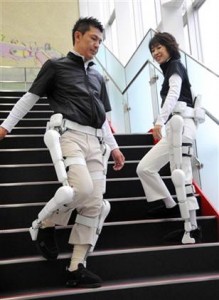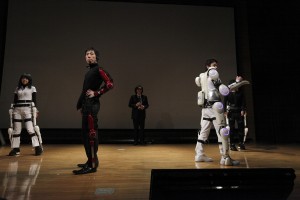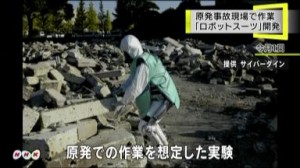Not many news stations talk about Fukushima any more. After the 9.0 magnitude earthquake struck Northeast Japan, I remember being glued to the computer for hours and hours trying to get the most recent news on the situation in Japan. What is happening now? A quick search turned up a news headline on robot suits in Fukushima. A robot suit that reads signals from the brain seems to be the most recent solution to Northeast Japan’s nuclear radiation problem.
How do robot suits tie into this event? A major concern still is the radiation leak from the Dai-ichi Nuclear Power Plant in Fukushima prefecture. To fix the damage done by the earthquake and tsunami, power plant workers and rescue teams need protective gear against the high levels of radiation around the plant. However, the required metal suit can weigh up to 15kg—a significant hindrance to movement. A solution to this problem was a “robot suit.” Just by thinking “walk,” the robot motor helps move the legs for you.

The robot suit was actually invented three years ago at the University of Tsukuba in Tokyo. It was initially meant for elderly and handicapped people to assist in walking. They named it HAL, for “Hybrid Assistive Limb”. When the wearer tries to walk, nerve signals are sent to the leg muscles. Such signals are detected by the suit through the skin, and triggers the robot limb to move along with the leg. This battery-powered movement and firm structure of HAL enables it to offer extra support for movement.
After 3 years, further developments on HAL added support for the arms as well.

This video from the International Forum on Cybernics 2011 introduces HAL.
Here are photos from the same event.
Researchers are now investigating a new application for this technology. Tsukuba University suggested that the robot will be useful not only for the disabled and care for the elderly, but also for heavy labor and rescue work. Last week, Japanese news station NHK (link to original Japanese news) reported the use of this novel technology to solve the problem of radiation in the earthquake-struck nuclear power plant in Fukushima.

Experimental tests showed that this robot suit could carry weights up to 60kg. The inventor, Dr. Yoshiyuki Sankai, hopes that implementing HAL at Fukushima Dai-ichi Nuclear Plant would make possible previously risky recovery work and allow longer hours of rescue efforts.
At the time I saw this news on NHK, I could not find information about this initiative in English. However, only two days later, the Telegraph picked up on this. Thought-controlled robots–what a way to bring back attention to Fukushima.
4 replies on “Robot suits put to use in countering radiation in Fukushima”
Is it too much of a coincidence that it is named HAL? I immediately thought of HAL 9000 from 2001: A Space Odyssey. Reference aside, this technology could be the start of something much greater.
My aunt is going to be proud when she sees this as an alumni from Tsukuba University 20 years ago. This really is similar to LOPES, except it is much smaller and seems more convenient. I wonder how the signal can detect the skin in the legs? By that do you mean like the contraction of muscles?
Wow..I was shocked by this post as I’ve been preparing my post about Fukushima as well… I guess I have to post them soon!
I was impressed by Dr. Sankai and his research group’s effort to communicate this work internationally. Their international conference, video, and website to update their progress are all available in English.